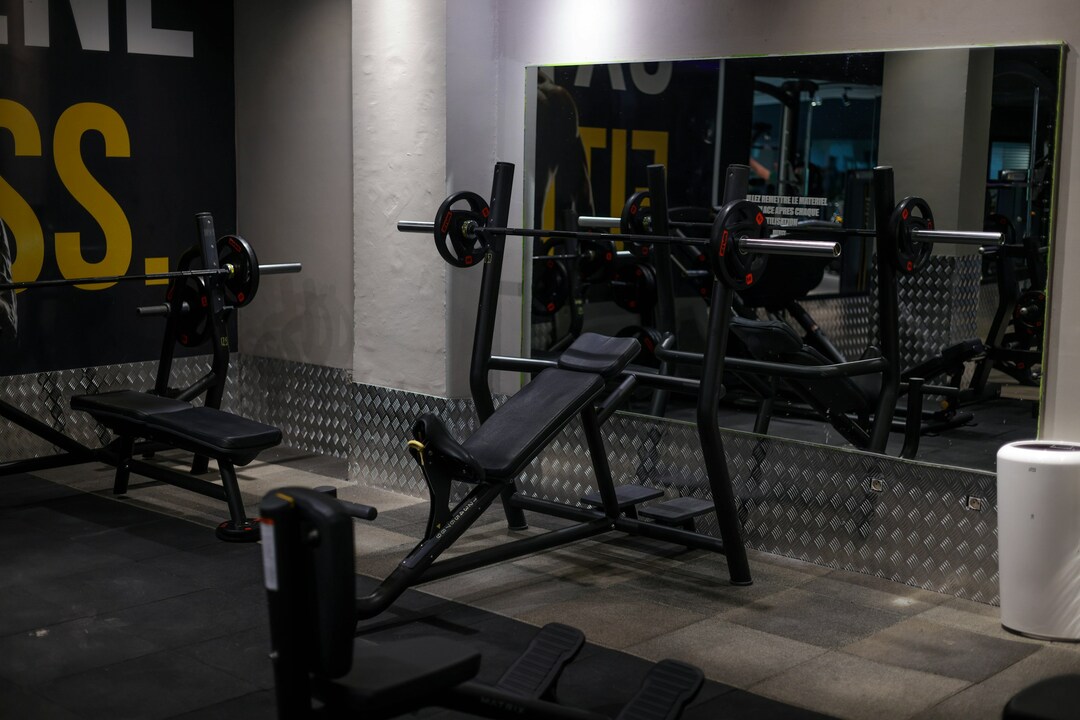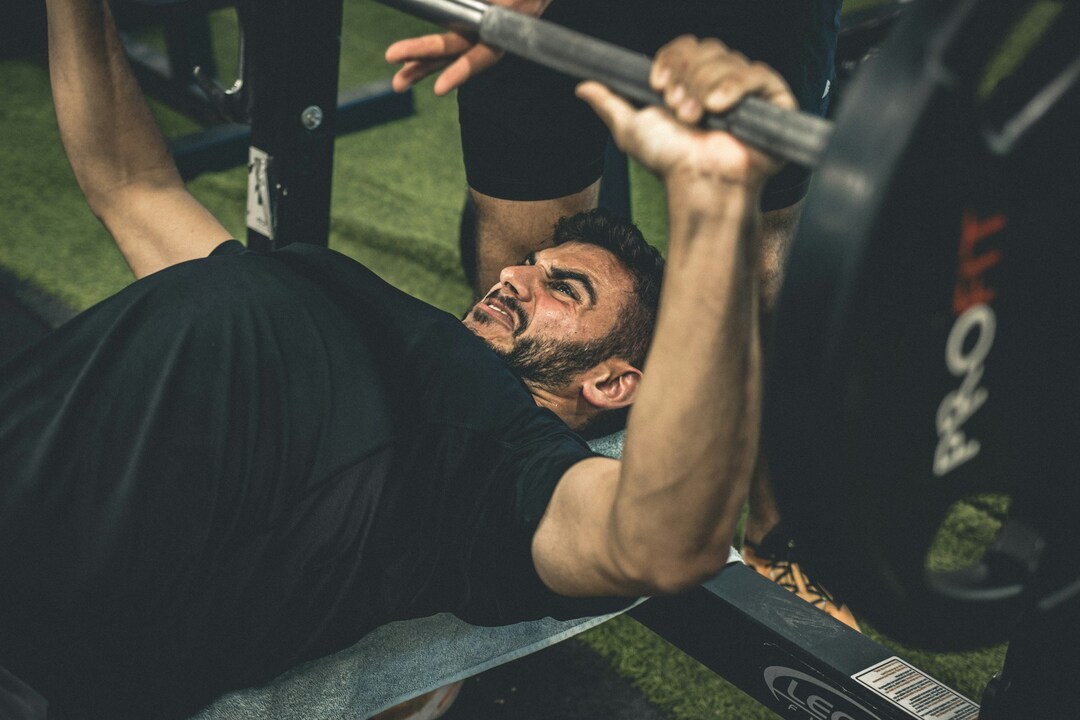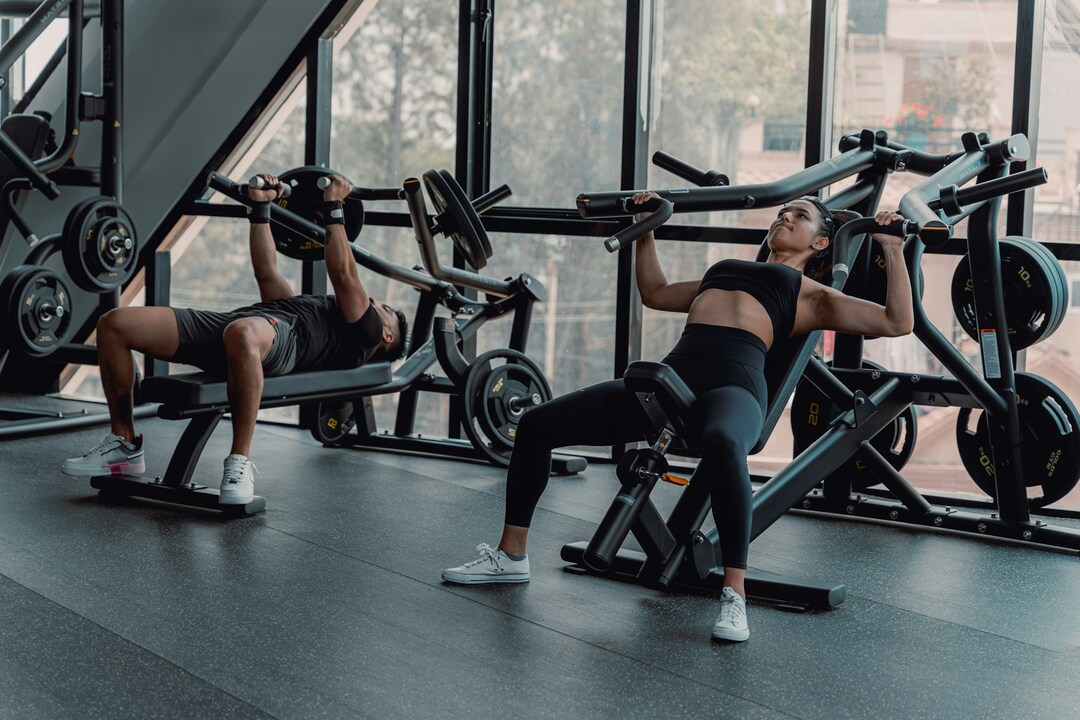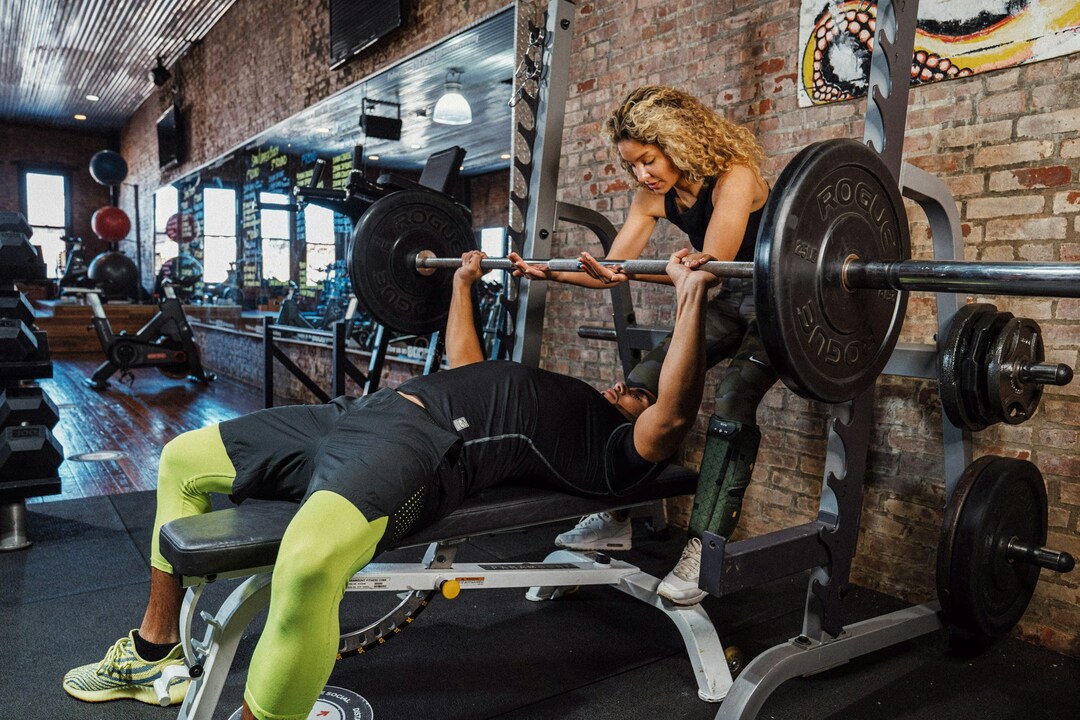What is the Average Bench Press By Age?

Find out how your strength stacks up! Discover the average bench press by age and see where you rank across different fitness levels.
Bench press numbers show up in many of the Best Fitness Apps, but they rarely tell you what those numbers mean for your age, sex, or training level. Are you a 30-year-old beginner wondering whether your one-rep max is on track, or a 50-year-old trying to outlift the inevitable strength dip?
This guide lays out average bench press numbers by age, along with clear strength standards, bodyweight ratios, and lifting benchmarks, so you can set realistic targets and track tangible progress.
To turn those benchmarks into a plan you will follow, GetFit AI uses simple, personalized guidance from an AI fitness app to match your age, sex, and experience to attainable bench press goals and practical workouts.
Summary

- Bench press strength in men generally rises through the teens, peaks in the 20s and 30s, then declines after about 40, with men aged 20 to 29 averaging roughly 100% of bodyweight and men aged 30 to 39 averaging about 90% of bodyweight. This is where GetFit AI fits in, matching age, sex, and experience to attainable bench press goals and practical workouts.
- Women's bench averages peak in early adulthood and decline with age, for example, women 20 to 29 average about 65% of bodyweight, while women 40 to 49 average roughly 55% of bodyweight. GetFit AI addresses this by adjusting programming around recovery needs and technique priorities common to different decades.
- Relative strength ratios provide a clearer context than raw pounds, with Strength Level reporting an average male bench of 217 lb and noting 1.5 times bodyweight (about 225 lb) as markers of distinctly strong performance. This is where GetFit AI fits in, using bodyweight ratios and trend tracking rather than headline maxes to guide training decisions.
- Make testing and progression meaningful by testing an actual one-rep max no more than twice a year, estimating via heavy triples otherwise, and planning small load increases of 2.5 to 5 percent every 2 to 4 weeks. GetFit AI addresses this by auto-adjusting weekly volume and suggesting incremental progressions based on tracked performance and recovery.
- Durable progress shows up in submax indicators rather than single maxes, for example, improving bar speed at 80 to 85 percent of max and making gains across 8 to 12 week cycles signal real adaptation more than a one-off PR. This is where GetFit AI fits in, monitoring submax speed, pause-rep trends, and cycle length to prioritize repeatable gains over headline lifts.
- Adaptive programming that scales stimulus to readiness preserves long-term strength, and GetFit AI user data shows 80% of users reported improved fitness within three months, while users saved an average of $200 per month on personal training costs. GetFit AI addresses this by automatically scaling sets, intensity, and accessory choices in response to recovery inputs or performance trends.
Average Bench Press By Age For Men

Average bench press strength for men tends to climb through the teens, peak in the 20s and 30s, then drift downward after about 40 as recovery and muscle mass change. Treat these figures as practical benchmarks you can use to set realistic goals, not rigid standards you must match.
What does the curve look like across the lifespan?
Strength increases sharply during adolescence, with big jumps between 15 and the early 20s as muscle and neural coordination mature. Between roughly 20 and 40 years old, the averages flatten, reflecting an optimal zone where training consistency and recovery balance. After 40, most men see a steady, measurable decline tied to lower muscle mass and slower recovery, which is why a 50-year-old’s typical lifts look noticeably lighter than a 25-year-old’s.
How should you read specific benchmarks?
Benchmarks give context, not judgment. For example, Fitness Volt’s 2023 data shows that Men aged 20-29 can bench press an average of 100% of their body weight. Captures that early-adult peak where many lifters hit their natural strength ceiling with consistent training. By contrast, Fitness Volt’s 2023 finding that Men aged 30-39 can bench press an average of 90% of their body weight shows a modest drop that’s typical as priorities, sleep, and recovery windows shift.
Why does decline happen, and what breaks routines?
This pattern appears across recreational lifters and athletes alike: early gains depend on time under tension and neural adaptation, then subtle shifts in hormone profiles, sleep, and life stressors create a gap between what you used to do and what you can recover from now. It’s exhausting when your numbers slip and you feel like the body that once responded quickly now needs longer to repair. That frustration is real, and it often leads to two mistakes: chasing the old weights without adjusting recovery, or quitting strength work entirely because progress slows.
How should you use these averages to set goals?
If you’re under 40, prioritize progressive overload and recovery to exploit the plateau window; think of strength like a savings account, deposits compound fast when you keep contributing. After 40, shift the focus: keep intensity but reduce volume, emphasize mobility and sleep, and measure progress in movement quality and longevity as much as raw pounds. Use age-based averages to create tiered targets: attainable short-term lifts that build confidence, and longer-term cycles that aim for sustainable strength.
Table Overview
Age Strength Standards
Age 15
Beginner: 88 / 40
Novice: 131 / 60
Intermediate: 185 / 84
Advanced: 248 / 113
Elite: 317 / 144
Age 25
Beginner: 103 / 47
Novice: 154 / 70
Intermediate: 217 / 99
Advanced: 291 / 132
Elite: 372 / 169
Age 40
Beginner: 103 / 47
Novice: 154 / 70
Intermediate: 217 / 99
Advanced: 291 / 132
Elite: 372 / 169
Age 50
Beginner: 92 / 42
Novice: 137 / 62
Intermediate: 193 / 88
Advanced: 259 / 118
Elite: 331 / 150
Age 70
Beginner: 63 / 29
Novice: 94 / 43
Intermediate: 132 / 60
Advanced: 177 / 80
Elite: 227 / 103
Age 85
Beginner: 45 / 20
Novice: 67 / 30
Intermediate: 95 / 43
Advanced: 127 / 58
Elite: 163 / 74
Age 90
Beginner: 41 / 19
Novice: 60 / 27
Intermediate: 85 / 39
Advanced: 115 / 52
Elite: 146 / 66
Most people train the way they always have because it feels familiar, and that’s understandable. The familiar approach works at first, but as life gets more complex, training that ignores recovery and periodization becomes counterproductive, leading to stalled lifts and recurring injuries. Platforms like GetFit AI provide an alternative path: they personalize plans to age, recovery markers, and goals, automatically adjusting volume and tempo as stressors change, so you preserve long-term progress without guessing every workout.
What I want you to hold onto emotionally
Men tell us they want honest, achievable targets more than lofty benchmarks. That desire to set realistic goals is motivating; it keeps people in the gym and reduces the shame cycle that comes from chasing past numbers. Use these averages to clarify what matters for your stage of life, then focus daily on habits that sustain strength over the long term.
Next we confront a comparison that will force you to reassess how we measure strength and why one benchmark rarely tells the whole story.
Related Reading
- Average Grip Strength Male
- How Many Pull Ups Should I Be Able To Do
- How Much Does A Bench Press Bar Weigh
- Grip Strength Chart
- Average Male Bench Press
- How Much Can The Average Man Bench Press
- Average Bench Press
Average Bench Press By Age for Women

Bench press averages for women rise into the 20s and then drift downward with age, so use them as directional benchmarks rather than fixed expectations. They show where typical strength sits for a stage of life and help you plan steady, safe progress instead of chasing a single number.
What pattern do averages show through early adulthood and midlife?
Data collected across lifters shows relative strength peaks in early adulthood, when training adaptation and recovery windows are most expansive. For example, RitFit Sports (2021) reports that women aged 20-29 can bench press an average of 65% of their body weight, which captures the early-adult peak in strength relative to body mass. From there, averages decline gradually as cumulative life stressors and recovery needs shift with age.
Why does that decline happen, and how does it feel?
This pattern appears consistently: hormone shifts, slower protein synthesis, and small drops in muscle cross-section add up over the years, so a lifter who was strongest in her late 20s will often see lighter numbers by her 40s. It’s exhausting when your progress stalls and training feels less responsive; many women describe frustration at losing capacity they once counted on, and older lifters can feel disheartened when daily tasks start to feel harder. The emotional reality matters because discouragement changes behavior, and behavior changes outcomes.
How should you use these averages as practical benchmarks?
Treat the numbers as signposts, not moral judgments. If a benchmark sits above your current lift, break the gap into micro goals: add 2.5 to 5 percent of load every 4 to 6 weeks, or swap one heavy session for a tempo-controlled set to build pressing tolerance. The familiar approach is to follow cookie-cutter programs because they are simple, but this creates a hidden cost: rigid plans ignore personal recovery and life stress, leading to plateaus and avoidable injuries. Solutions like personalized AI training platforms provide adaptive programming that tweaks volume, frequency, and tempo based on recovery signals, keeping progress steady without forcing you to chase weights unsafely.
What practical changes preserve strength as you age?
Think of strength like a wooden bridge: traffic reinforces the planks, but without regular, staged loading, the structure loses capacity. Preserve bench strength by intentionally increasing training density, keeping at least one heavy compound day per week, prioritizing protein intake around workouts, and using more extended rest between sets when life stress spikes. When mobility or shoulder pain appears, reduce load and add positional work rather than quitting pressing altogether; minor, consistent adjustments protect both gains and motivation.
Table Overview
Strength Standards by Age
Age 15
- Beginner: 33 / 15
- Novice: 59 / 27
- Intermediate: 95 / 43
- Advanced: 139 / 63
- Elite: 190 / 86
Age 25
- Beginner: 38 / 17
- Novice: 69 / 31
- Intermediate: 111 / 50
- Advanced: 164 / 75
- Elite: 223 / 101
Age 40
- Beginner: 38 / 17
- Novice: 69 / 31
- Intermediate: 111 / 50
- Advanced: 164 / 75
- Elite: 223 / 101
Age 50
- Beginner: 34 / 15
- Novice: 62 / 28
- Intermediate: 99 / 45
- Advanced: 146 / 66
- Elite: 198 / 90
Age 70
- Beginner: 23 / 10
- Novice: 42 / 19
- Intermediate: 68 / 31
- Advanced: 100 / 45
- Elite: 136 / 62
Age 85
- Beginner: 17 / 8
- Novice: 30 / 14
- Intermediate: 49 / 22
- Advanced: 71 / 32
- Elite: 97 / 44
Age 90
- Beginner: 15 / 7
- Novice: 27 / 12
- Intermediate: 44 / 20
- Advanced: 64 / 29
- Elite: 88 / 40
What does the decade-by-decade context add?
Averages give perspective, so you can read where you are and where you can reasonably head next. For women in their 40s, the trend shows a measurable dip compared with the 20s. That trajectory is typical: RitFit Sports (2021) shows that women aged 40-49 can bench press an average of 55% of their body weight, which helps explain why programming and recovery need to shift with age. Use that context to prioritize habits that sustain strength long term, not temporary peaks.
That simple shift in how you frame averages changes everything about how you plan progression and protect longevity — and that leads directly into a surprising comparison across sexes that you won’t want to skip.
How Much Should Men Be Able to Bench Press?

A reasonable yardstick for how much a man should bench press depends on what you want the lift to do for you, not some universal number. Aim your targets around relative strength, training phase, and recovery capacity so the weight you chase actually improves performance, movement quality, or daily function.
What does a “good” bench press mean for everyday progress?
Think of “good” as a practical training milestone, not a trophy. According to Strength Level, a good bench press for a male lifter is 1.5 times bodyweight. That ratio marks a level where pressing ability meaningfully exceeds basic daily-strength needs and signals a strong upper body, assuming sound technique and low injury history. Use ratios like this to choose exercises, not to judge every session; a 1.5x target guides programming choices, not mood.
How should you structure testing and tracking so the numbers mean something?
Test an actual one-rep max no more than twice a year if you lift regularly; otherwise, estimate 1RM from heavy sets of three to five reps and track trends weekly. Record five variables each session: weight and reps, bar speed, perceived exertion on a 1 to 10 scale, and recovery score; those five data points let you separate a bad day from an actual regression. When you plan progress, add 2.5 to 5 percent of load every 2 to 4 weeks, or convert gains into additional clean reps at the same weight, because load increases become harder to chase as relative strength rises.
What breaks comparisons between lifters, and how do you avoid that trap?
Comparisons fail when you look only at raw pounds. Bodyweight swings, limb length, joint tolerance, and program age all skew the number. Treat raw numbers as context, not verdict. If someone benches 225 pounds but weighs 210, their relative strength differs from a 165-pound lifter pressing the same load. Use bodyweight ratios, pressing frequency, and consistency over a three-month block to ensure fair and proper comparisons.
Most people follow templated plans because they are familiar and straightforward, and that works for a while. The hidden cost appears when life stress, recovery, or past injuries change how much volume you can handle, then the same template stalls progress and raises injury risk. Platforms like GetFit AI remove the guesswork, adjusting weekly volume, sets, and intensity based on recovery inputs and performance trends, so users keep moving toward realistic strength gains without constant program tinkering.
Which technical details actually improve your bench, not just the number on the bar?
Small technique changes yield significant returns: grip width that matches your limb geometry, consistent scapular positioning at setup, and controlled eccentric tempo all increase effective force without adding risky load. Measure bench progress with quality metrics —for example, increasing bar speed to 85 percent of max or adding a strict-pause set —rather than chasing raw weight alone. That shift lets you build durable strength instead of brittle numbers.
How do you set milestones that keep you motivated and safe?
Break long-term goals into 8 to 12-week cycles with one clear focus, such as adding 5 to 10 pounds to an estimated 1RM, improving bar speed, or increasing paused-rep tolerance. If you need a population reference to orient planning, treat the overall mean as context, not a mandate, because averages do not capture individual recovery or injury history; still, you can use broad population markers to design progressive overload and recovery windows. Train with the mindset that progress is a string of small, provable wins, not a single headline lift.
Bench press is less a test of ego than a finely tuned instrument; treat it like tuning an engine, where timing, components, and steady calibration matter more than maximum RPMs.
That raises a question you probably did not expect about how gender and physiology change the conversation next, and it is not what most people assume.
How Much Should Women Be Able to Bench Press?

Women’s bench capacity should be judged by what it does for your movement, work capacity, and confidence, not by a single headline number. Aim for steady, testable progress that fits your body, recovery, and life demands, and treat any given poundage as a checkpoint on a longer trend.
What should you prioritize over a target weight?
When we reorganized training for clients who felt stuck for 8 to 12 weeks, the pattern was clear: the fastest, safest gains came from improving pressing tolerance and technique first, then adding load. That means focusing on consistent bench frequency, controlled eccentrics, and a handful of overloaded accessory movements rather than chasing a one-rep max every session. If you can increase reps at a given weight or add speed on an 85 percent set, you are moving in the right direction.
Where do program design and recovery intersect?
This is a constraint problem: if you can recover, add intensity; when life stress rises, lower volume and protect quality. Practically, cycle 6 to 12 weeks with a clear focus, mix hypertrophy blocks (3 to 5 sets of 6 to 12 reps) and strength blocks (3 to 6 sets of 2 to 5 reps), and schedule a deload week after each block. Prioritize joint prep and slow eccentrics during higher-volume phases so connective tissue adapts with the muscle, not after the fact.
Why do most people stall, and what actually fixes it?
Most people run cookie-cutter programs because they are familiar, and that works early on. As volume accumulates, technique frays, shoulder or elbow soreness appears, and progress stalls because the program never adjusts. Platforms like GetFit AI provide adaptive programming that reduces volume when recovery metrics dip, swaps in tempo or paused reps when technique degrades, and preserves long-term progress by matching stimulus to readiness.
Which tests and accessories give the most return on time invested?
Use submax tests, such as a heavy triple or a controlled paused double, to estimate strength without risking an all-out max. Add two focused accessory movements twice weekly, for example, a close-grip bench or floor press for lockout, and a face-pull plus banded pull-aparts for scapular control, each with 3 to 5 sets of 6 to 12 reps.
For perspective on population spread, according to trength Level, the average bench press for a male lifter is 217 lb, which shows how raw numbers cluster in large samples, and Strength Level, for a male lifter, a bench press of 225 lb is considered advanced, which illustrates where an "advanced" mark sits for a different population, not a target for everyone.
How do you keep motivation without comparing yourself to others?
Comparison erodes progress when it leads to discouragement or reckless jumps in load. Treat your training like calibrating an instrument: minor, repeatable tweaks find the clearest signal. Track trendlines, celebrate tighter technique and extra clean reps, and set micro-goals like "add one strict paused rep at a given weight in six weeks." That approach protects confidence and makes weekly wins concrete.
That familiar tug between social benchmarks and practical progress is precisely what makes the following question so charged.
Related Reading
- Do Pull Ups Work the Chest
- Bench Press Standards
- Average Male Deadlift
- Good Bench Press Weight
- Average Deadlift Weight
- Grip Strength Norms
- Symmetric Strength
- Weightlifting Standards
- 1 Rep Max Chart
How Much Should I Be Able to Bench Press?

You should bench what helps you reach your goal while staying healthy: pick loads that leave you one or two demanding reps in reserve for growth phases, heavier singles when you are training strength, and higher-rep sets when you want size or endurance. Use short, testable milestones so the weight you chase becomes a series of provable wins, not a single headline number.
How do I set reasonable short-term targets?
Start with process goals, not a target plate. For eight to twelve weeks, aim to add one extra clean rep at a fixed weight, or to reduce perceived exertion by one point on a 1 to 10 scale for the same set, before increasing load. Track RPE, bar speed, and whether technique stays strict; those three things tell you if the nervous system and connective tissue are adapting, or if you are just accumulating fatigue. Think of small load increases like tightening a guitar string, tiny turns that keep the tone steady instead of snapping the string.
When should I pick an aspirational benchmark?
For a long-term bench target, use ratios and stages rather than a single pound. Consider Strength Level: A good bench press for a male lifter is 1.5 times bodyweight, which the site frames as a population-level indicator that a lifter has surpassed fundamental daily strength and entered a distinctly strong category, assuming solid technique and injury-free shoulders. Treat that ratio as a program-planning signpost: if you are far from it, prioritize volume and movement quality; if you are close, prioritize neural-strength work and recovery.
Most people follow templated programs because they are familiar and work early on. Over time, the hidden cost becomes clear, workouts stack into chronic soreness, and progress stalls because the plan never adjusted for life stress, recovery, or minor technique breakdowns. Platforms like AI fitness apps replace guesswork with automated adjustments to weekly volume, intensity, and accessory choices based on simple recovery inputs, so users keep moving forward without having to rewrite their plan each week manually.
What numbers actually show durable progress?
Raw maxes are flashy, but speed at submax loads, extra strict reps, and pain-free shoulders predict long-term gains better than a single heavy lift. If your bar speed improves from 80 to 85 percent of max, that means nervous system efficiency is rising. If your pause-reps increase without form collapse, your tendon and motor control capacity are improving—population labels like Strength Level reflect this. For a male lifter, a bench press of 225 lb is considered advanced. They help orient your training phase, not for setting your mood for the week.
This challenge appears across beginners and experienced lifters alike: frustration when numbers do not match effort. When we shifted a client from chasing singles to a rep-first progression over eight weeks, they regained confidence because the metric changed from a fragile one-rep peak to consistent, repeatable improvements. That emotional shift matters because confidence steadies behavior, and steady behavior produces strength.
What practical changes move the needle quickly and safely?
Use autoregulation, not rigid rules. On days your RPE drifts up or sleep is poor, drop volume and preserve intensity for neural work. Add one accessory movement focused on the sticking point for three to five sets of controlled reps, and schedule a deload every fourth week. Treat setup as part of the lift build, not decoration: consistent scapular position, grip width matched to your limb lengths, and a controlled eccentric gives you more force on the concentric without adding risky load. Picture the bench press like tuning a car engine, where timing, compression, and minor adjustments beat brute horsepower alone.
Ready to train like the legends and finally achieve the body you've always wanted? GetFit AI's AI fitness trainer app lets you follow the exact workout routines that made Arnold Schwarzenegger, Kobe Bryant, Cristiano Ronaldo, Serena Williams, and 11+ other elite athletes into champions, and you can also chat with them whenever you need guidance or motivation.
Download the #1 rated AI fitness app for free today to get fit for less than the cost of a single month's gym membership, because greatness isn't from birth, it's built one workout at a time.
The following section will pull back the curtain on a surprising truth about copying athletes and change how you pick the workouts you actually need.
Related Reading
- Average Deadlift Weight For Male
- Best Workout Apps
- Best Calisthenics Workout App
- Average Bench Press Kg By Age
- Best Free Workout Apps
- Best Gym Workout App
- Average Deadlift Weight Kg
- Best Hiit Workout App
- Average Bench Press By Age 16
- Best Workout Tracker App
Make Your Favorite Athlete Your Fitness Trainer | Try GetFit AI's AI Trainer App for Free Today 💪
If you want training that fits your age, recovery, and daily schedule while keeping coaching human and motivating, I recommend considering GetFit AI; the clear pattern among users is that programs that match life, not force it, sustain progress and confidence. The outcomes are concrete: in the GetFit AI User Survey, 80% of users reported improved fitness levels within 3 months, and in the GetFit AI Cost Analysis, Users saved an average of $200 per month on personal training costs.




.png)











